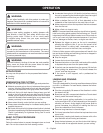
10 — English
Do not cut from a ladder; this is extremely dangerous.
Leave this operation for professionals.
Do not make the flush cut next to the main limb or trunk
until you have cut off the limb further out to reduce the
weight. Following proper cutting procedures will prevent
stripping the bark from the main member.
Do not use the pruner for felling or bucking.
To prevent electrocution, do not operate within 50 ft. of
overhead electrical lines.
Keep bystanders at least 50 ft. away.
POSITION FOR STARTING
See Figure 9.
Lay the pruner on the ground and ensure that no objects or
obstructions are in the immediate vicinity. Make sure nothing
can come in contact with the bar and chain. Ensure that the
bar and chain is not touching the ground.
OPERATION
WARNING:
When servicing, use only identical replacement parts.
Use of any other parts may create a hazard or cause
product damage.
WARNING:
Always wear safety goggles or safety glasses with side
shields during power tool operation or when blowing
dust. If operation is dusty, also wear a dust mask.
WARNING:
Before inspecting, cleaning or servicing the unit (except
for carburetor adjustments), shut off engine, wait for all
moving parts to stop, and disconnect spark plug wire
and move it away from spark plug. Failure to follow
these instructions can result in serious personal injury or
property damage.
STARTING AND STOPPING
See Figures 10 - 12.
To start a cold engine:
DO NOT squeeze the throttle trigger until the engine starts
and runs.
Lay the trimmer on a flat, bare surface.
PRIME - Press the primer bulb 7 times.
SET the start lever to the START position.
PULL the rope until the engine starts.
Allow the engine to run for 6-10 seconds.
Squeeze trigger lock and throttle trigger.
NOTE: Squeezing and releasing the throttle trigger releases
the start lever to the RUN position.
To start a warm engine:
PULL the rope until the engine starts.
To stop the engine:
Press and hold the switch in the stop “ ” position until the
engine stops.
MAINTENANCE
GENERAL MAINTENANCE
Avoid using solvents when cleaning plastic parts. Most
plastics are susceptible to damage from various types of
commercial solvents and may be damaged by their use. Use
clean cloths to remove dirt, dust, lubricant, grease, etc.
WARNING:
Do not at any time let brake fluids, gasoline, petroleum-
based products, penetrating lubricant, etc., come in con-
tact with plastic parts. Chemicals can damage, weaken, or
destroy plastic, which may result in serious personal
injury.
All pruner service, other than the items listed in the instruc-
tion manual maintenance instructions, should be performed
by competent pruner service personnel. (For example, if
improper tool is used to hold the flywheel in order to remove
the clutch, structural damage to the flywheel could occur
and subsequently could cause the flywheel to burst).


















